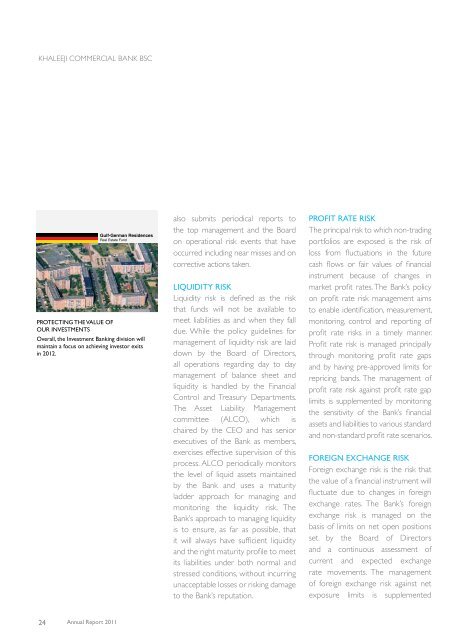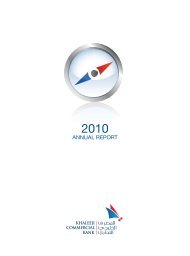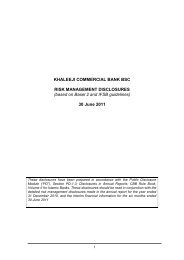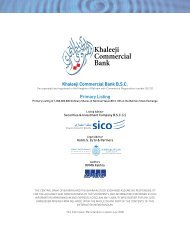2011 Annual Report - Khaleeji Commercial Bank BSC
2011 Annual Report - Khaleeji Commercial Bank BSC
2011 Annual Report - Khaleeji Commercial Bank BSC
Create successful ePaper yourself
Turn your PDF publications into a flip-book with our unique Google optimized e-Paper software.
KHALEEJI COMMERCIAL BANK <strong>BSC</strong><br />
GGR Inv Update <strong>2011</strong> H1 Review E V5.indd 1<br />
Protecting the Value of<br />
Gulf-German Residences<br />
Real Estate Fund<br />
Investor Update<br />
H1 <strong>2011</strong> Review<br />
Issued December <strong>2011</strong><br />
Strictly Private & Confidential<br />
Our Investments<br />
Overall, the Investment <strong>Bank</strong>ing division will<br />
maintain a focus on achieving investor exits<br />
in 2012.<br />
1/11/12 4:43 PM<br />
also submits periodical reports to<br />
the top management and the Board<br />
on operational risk events that have<br />
occurred including near misses and on<br />
corrective actions taken.<br />
Liquidity Risk<br />
Liquidity risk is defined as the risk<br />
that funds will not be available to<br />
meet liabilities as and when they fall<br />
due. While the policy guidelines for<br />
management of liquidity risk are laid<br />
down by the Board of Directors,<br />
all operations regarding day to day<br />
management of balance sheet and<br />
liquidity is handled by the Financial<br />
Control and Treasury Departments.<br />
The Asset Liability Management<br />
committee (ALCO), which is<br />
chaired by the CEO and has senior<br />
executives of the <strong>Bank</strong> as members,<br />
exercises effective supervision of this<br />
process. ALCO periodically monitors<br />
the level of liquid assets maintained<br />
by the <strong>Bank</strong> and uses a maturity<br />
ladder approach for managing and<br />
monitoring the liquidity risk. The<br />
<strong>Bank</strong>’s approach to managing liquidity<br />
is to ensure, as far as possible, that<br />
it will always have sufficient liquidity<br />
and the right maturity profile to meet<br />
its liabilities under both normal and<br />
stressed conditions, without incurring<br />
unacceptable losses or risking damage<br />
to the <strong>Bank</strong>’s reputation.<br />
Profit Rate Risk<br />
The principal risk to which non-trading<br />
portfolios are exposed is the risk of<br />
loss from fluctuations in the future<br />
cash flows or fair values of financial<br />
instrument because of changes in<br />
market profit rates. The <strong>Bank</strong>’s policy<br />
on profit rate risk management aims<br />
to enable identification, measurement,<br />
monitoring, control and reporting of<br />
profit rate risks in a timely manner.<br />
Profit rate risk is managed principally<br />
through monitoring profit rate gaps<br />
and by having pre-approved limits for<br />
repricing bands. The management of<br />
profit rate risk against profit rate gap<br />
limits is supplemented by monitoring<br />
the sensitivity of the <strong>Bank</strong>’s financial<br />
assets and liabilities to various standard<br />
and non-standard profit rate scenarios.<br />
Foreign Exchange Risk<br />
Foreign exchange risk is the risk that<br />
the value of a financial instrument will<br />
fluctuate due to changes in foreign<br />
exchange rates. The <strong>Bank</strong>’s foreign<br />
exchange risk is managed on the<br />
basis of limits on net open positions<br />
set by the Board of Directors<br />
and a continuous assessment of<br />
current and expected exchange<br />
rate movements. The management<br />
of foreign exchange risk against net<br />
exposure limits is supplemented<br />
24<br />
<strong>Annual</strong> <strong>Report</strong> <strong>2011</strong>










